Professional Issues Assignment Reports
VerifiedAdded on 2022/09/15
|11
|3107
|10
AI Summary
Contribute Materials
Your contribution can guide someone’s learning journey. Share your
documents today.
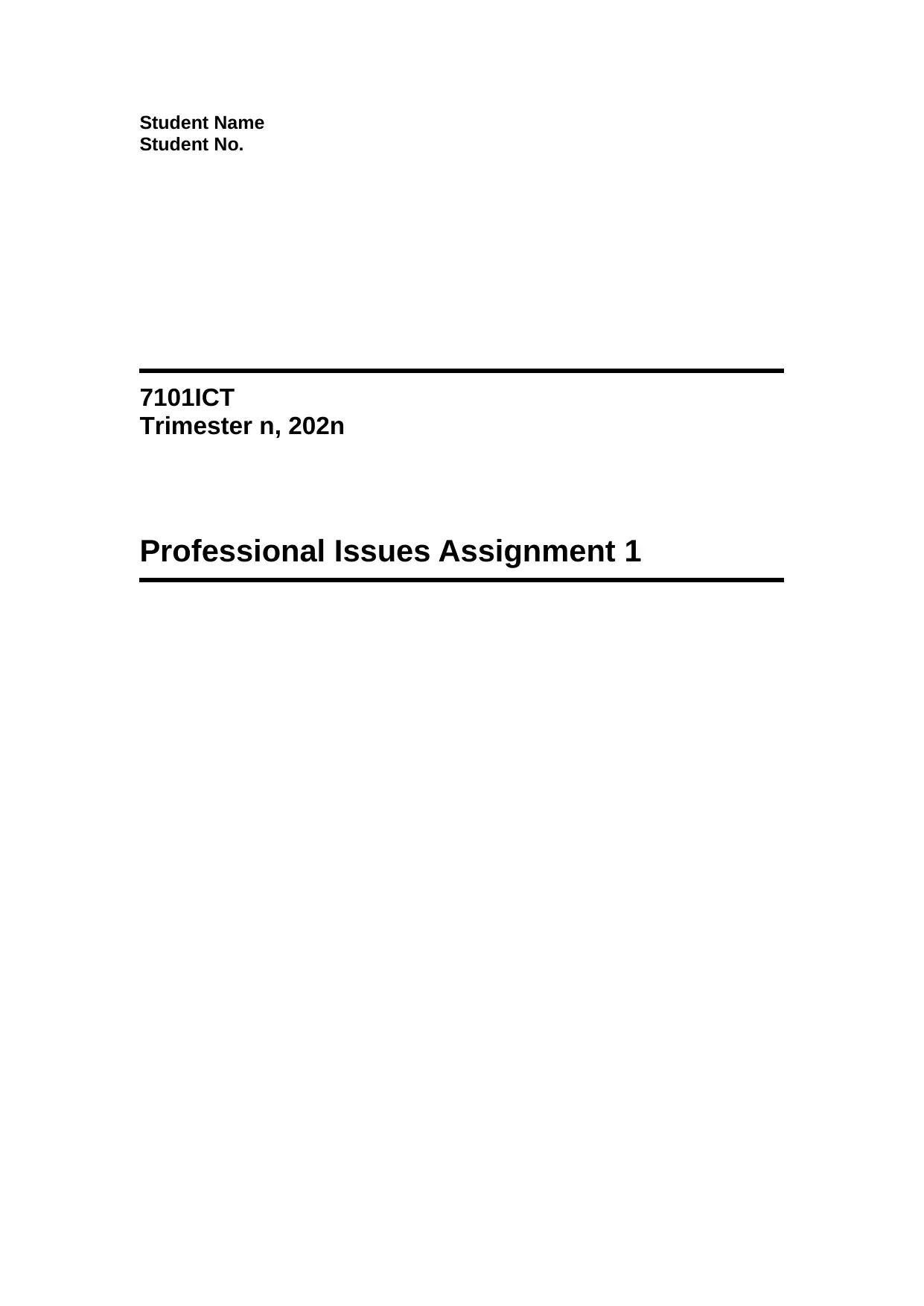
Student Name
Student No.
7101ICT
Trimester n, 202n
Professional Issues Assignment 1
Student No.
7101ICT
Trimester n, 202n
Professional Issues Assignment 1
Secure Best Marks with AI Grader
Need help grading? Try our AI Grader for instant feedback on your assignments.
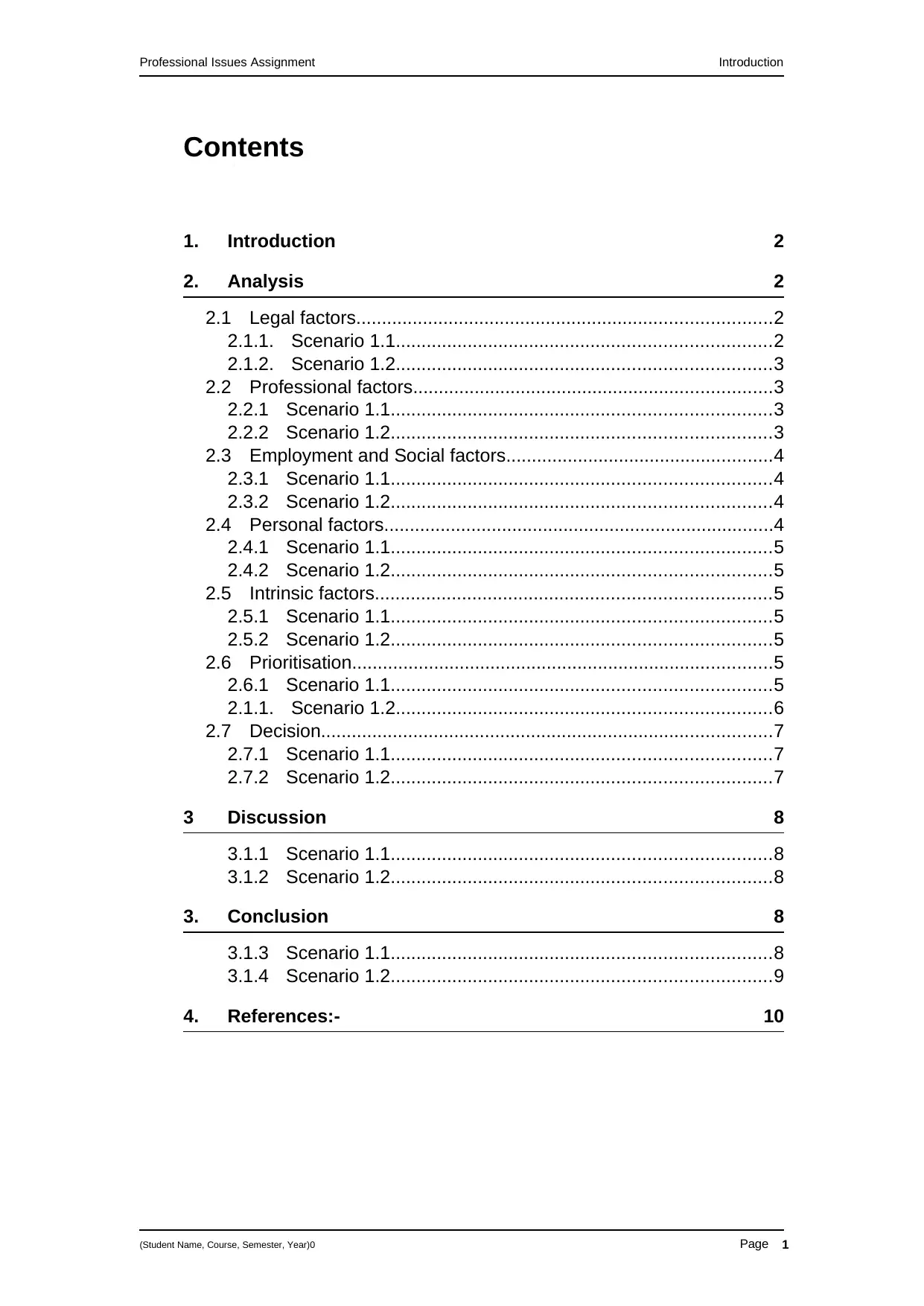
Professional Issues Assignment Introduction
Contents
1. Introduction 2
2. Analysis 2
2.1 Legal factors.................................................................................2
2.1.1. Scenario 1.1.........................................................................2
2.1.2. Scenario 1.2.........................................................................3
2.2 Professional factors......................................................................3
2.2.1 Scenario 1.1..........................................................................3
2.2.2 Scenario 1.2..........................................................................3
2.3 Employment and Social factors....................................................4
2.3.1 Scenario 1.1..........................................................................4
2.3.2 Scenario 1.2..........................................................................4
2.4 Personal factors............................................................................4
2.4.1 Scenario 1.1..........................................................................5
2.4.2 Scenario 1.2..........................................................................5
2.5 Intrinsic factors.............................................................................5
2.5.1 Scenario 1.1..........................................................................5
2.5.2 Scenario 1.2..........................................................................5
2.6 Prioritisation..................................................................................5
2.6.1 Scenario 1.1..........................................................................5
2.1.1. Scenario 1.2.........................................................................6
2.7 Decision........................................................................................7
2.7.1 Scenario 1.1..........................................................................7
2.7.2 Scenario 1.2..........................................................................7
3 Discussion 8
3.1.1 Scenario 1.1..........................................................................8
3.1.2 Scenario 1.2..........................................................................8
3. Conclusion 8
3.1.3 Scenario 1.1..........................................................................8
3.1.4 Scenario 1.2..........................................................................9
4. References:- 10
(Student Name, Course, Semester, Year)0 Page 1
Contents
1. Introduction 2
2. Analysis 2
2.1 Legal factors.................................................................................2
2.1.1. Scenario 1.1.........................................................................2
2.1.2. Scenario 1.2.........................................................................3
2.2 Professional factors......................................................................3
2.2.1 Scenario 1.1..........................................................................3
2.2.2 Scenario 1.2..........................................................................3
2.3 Employment and Social factors....................................................4
2.3.1 Scenario 1.1..........................................................................4
2.3.2 Scenario 1.2..........................................................................4
2.4 Personal factors............................................................................4
2.4.1 Scenario 1.1..........................................................................5
2.4.2 Scenario 1.2..........................................................................5
2.5 Intrinsic factors.............................................................................5
2.5.1 Scenario 1.1..........................................................................5
2.5.2 Scenario 1.2..........................................................................5
2.6 Prioritisation..................................................................................5
2.6.1 Scenario 1.1..........................................................................5
2.1.1. Scenario 1.2.........................................................................6
2.7 Decision........................................................................................7
2.7.1 Scenario 1.1..........................................................................7
2.7.2 Scenario 1.2..........................................................................7
3 Discussion 8
3.1.1 Scenario 1.1..........................................................................8
3.1.2 Scenario 1.2..........................................................................8
3. Conclusion 8
3.1.3 Scenario 1.1..........................................................................8
3.1.4 Scenario 1.2..........................................................................9
4. References:- 10
(Student Name, Course, Semester, Year)0 Page 1
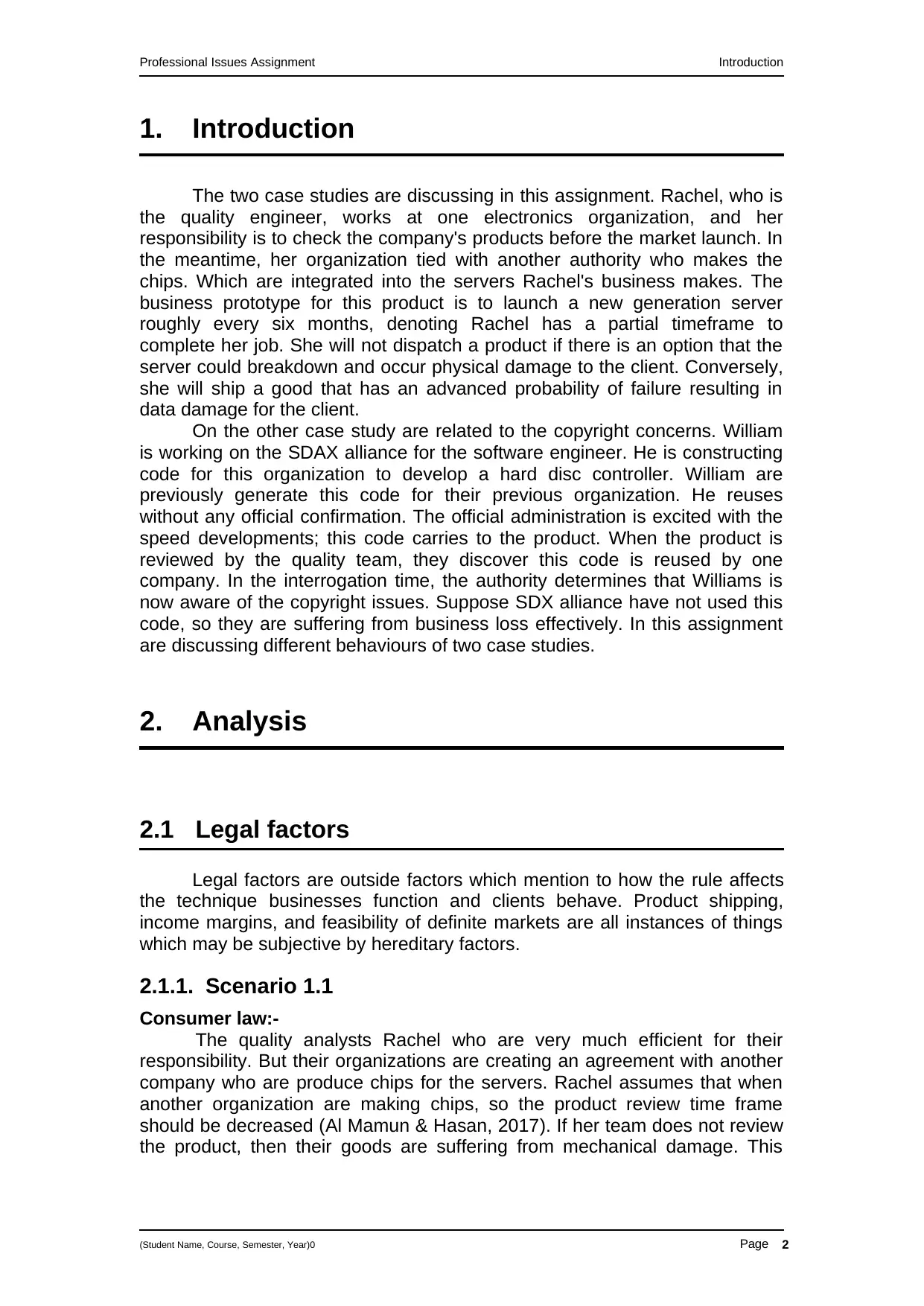
Professional Issues Assignment Introduction
1. Introduction
The two case studies are discussing in this assignment. Rachel, who is
the quality engineer, works at one electronics organization, and her
responsibility is to check the company's products before the market launch. In
the meantime, her organization tied with another authority who makes the
chips. Which are integrated into the servers Rachel's business makes. The
business prototype for this product is to launch a new generation server
roughly every six months, denoting Rachel has a partial timeframe to
complete her job. She will not dispatch a product if there is an option that the
server could breakdown and occur physical damage to the client. Conversely,
she will ship a good that has an advanced probability of failure resulting in
data damage for the client.
On the other case study are related to the copyright concerns. William
is working on the SDAX alliance for the software engineer. He is constructing
code for this organization to develop a hard disc controller. William are
previously generate this code for their previous organization. He reuses
without any official confirmation. The official administration is excited with the
speed developments; this code carries to the product. When the product is
reviewed by the quality team, they discover this code is reused by one
company. In the interrogation time, the authority determines that Williams is
now aware of the copyright issues. Suppose SDX alliance have not used this
code, so they are suffering from business loss effectively. In this assignment
are discussing different behaviours of two case studies.
2. Analysis
2.1 Legal factors
Legal factors are outside factors which mention to how the rule affects
the technique businesses function and clients behave. Product shipping,
income margins, and feasibility of definite markets are all instances of things
which may be subjective by hereditary factors.
2.1.1. Scenario 1.1
Consumer law:-
The quality analysts Rachel who are very much efficient for their
responsibility. But their organizations are creating an agreement with another
company who are produce chips for the servers. Rachel assumes that when
another organization are making chips, so the product review time frame
should be decreased (Al Mamun & Hasan, 2017). If her team does not review
the product, then their goods are suffering from mechanical damage. This
(Student Name, Course, Semester, Year)0 Page 2
1. Introduction
The two case studies are discussing in this assignment. Rachel, who is
the quality engineer, works at one electronics organization, and her
responsibility is to check the company's products before the market launch. In
the meantime, her organization tied with another authority who makes the
chips. Which are integrated into the servers Rachel's business makes. The
business prototype for this product is to launch a new generation server
roughly every six months, denoting Rachel has a partial timeframe to
complete her job. She will not dispatch a product if there is an option that the
server could breakdown and occur physical damage to the client. Conversely,
she will ship a good that has an advanced probability of failure resulting in
data damage for the client.
On the other case study are related to the copyright concerns. William
is working on the SDAX alliance for the software engineer. He is constructing
code for this organization to develop a hard disc controller. William are
previously generate this code for their previous organization. He reuses
without any official confirmation. The official administration is excited with the
speed developments; this code carries to the product. When the product is
reviewed by the quality team, they discover this code is reused by one
company. In the interrogation time, the authority determines that Williams is
now aware of the copyright issues. Suppose SDX alliance have not used this
code, so they are suffering from business loss effectively. In this assignment
are discussing different behaviours of two case studies.
2. Analysis
2.1 Legal factors
Legal factors are outside factors which mention to how the rule affects
the technique businesses function and clients behave. Product shipping,
income margins, and feasibility of definite markets are all instances of things
which may be subjective by hereditary factors.
2.1.1. Scenario 1.1
Consumer law:-
The quality analysts Rachel who are very much efficient for their
responsibility. But their organizations are creating an agreement with another
company who are produce chips for the servers. Rachel assumes that when
another organization are making chips, so the product review time frame
should be decreased (Al Mamun & Hasan, 2017). If her team does not review
the product, then their goods are suffering from mechanical damage. This
(Student Name, Course, Semester, Year)0 Page 2
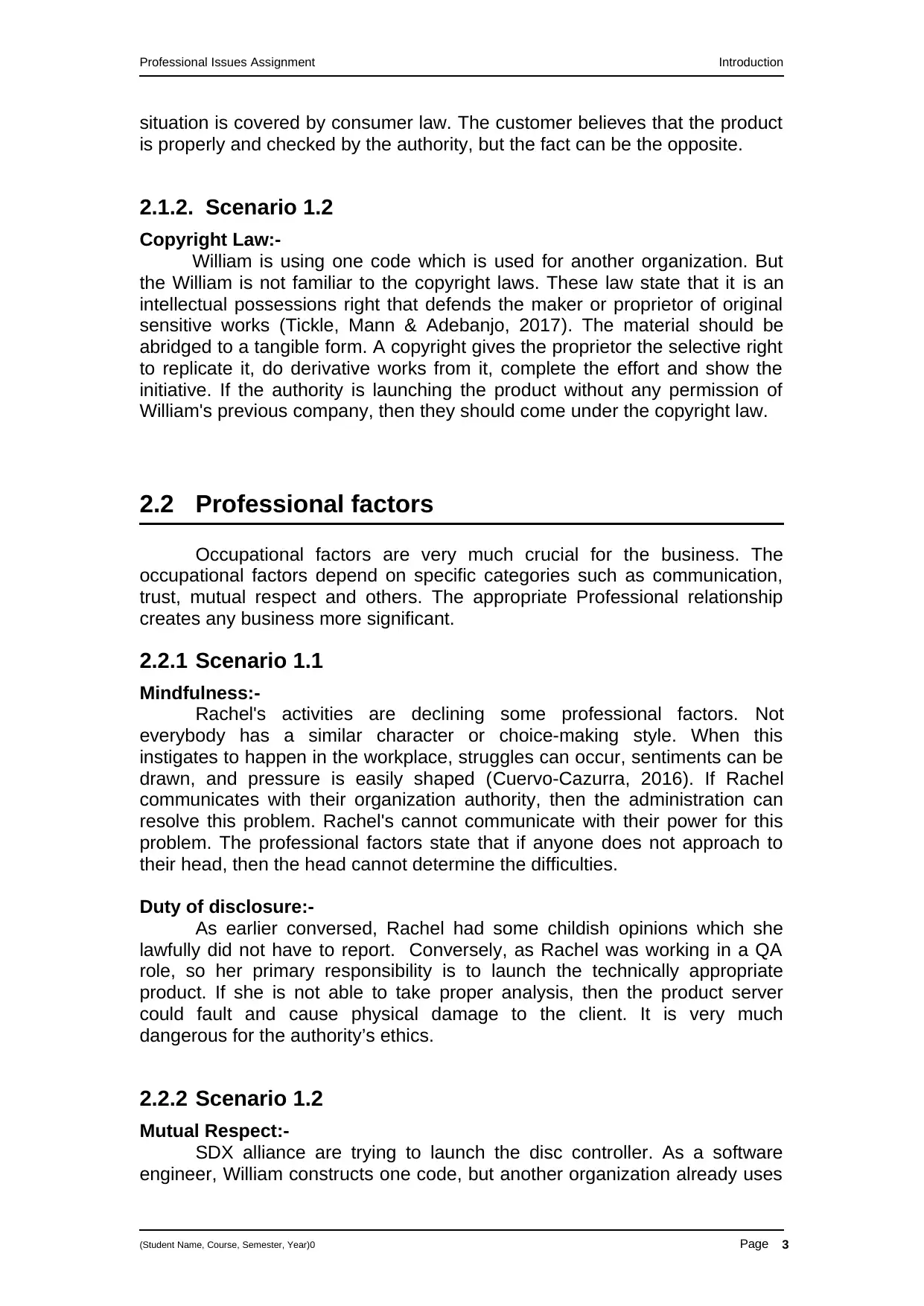
Professional Issues Assignment Introduction
situation is covered by consumer law. The customer believes that the product
is properly and checked by the authority, but the fact can be the opposite.
2.1.2. Scenario 1.2
Copyright Law:-
William is using one code which is used for another organization. But
the William is not familiar to the copyright laws. These law state that it is an
intellectual possessions right that defends the maker or proprietor of original
sensitive works (Tickle, Mann & Adebanjo, 2017). The material should be
abridged to a tangible form. A copyright gives the proprietor the selective right
to replicate it, do derivative works from it, complete the effort and show the
initiative. If the authority is launching the product without any permission of
William's previous company, then they should come under the copyright law.
2.2 Professional factors
Occupational factors are very much crucial for the business. The
occupational factors depend on specific categories such as communication,
trust, mutual respect and others. The appropriate Professional relationship
creates any business more significant.
2.2.1 Scenario 1.1
Mindfulness:-
Rachel's activities are declining some professional factors. Not
everybody has a similar character or choice-making style. When this
instigates to happen in the workplace, struggles can occur, sentiments can be
drawn, and pressure is easily shaped (Cuervo-Cazurra, 2016). If Rachel
communicates with their organization authority, then the administration can
resolve this problem. Rachel's cannot communicate with their power for this
problem. The professional factors state that if anyone does not approach to
their head, then the head cannot determine the difficulties.
Duty of disclosure:-
As earlier conversed, Rachel had some childish opinions which she
lawfully did not have to report. Conversely, as Rachel was working in a QA
role, so her primary responsibility is to launch the technically appropriate
product. If she is not able to take proper analysis, then the product server
could fault and cause physical damage to the client. It is very much
dangerous for the authority’s ethics.
2.2.2 Scenario 1.2
Mutual Respect:-
SDX alliance are trying to launch the disc controller. As a software
engineer, William constructs one code, but another organization already uses
(Student Name, Course, Semester, Year)0 Page 3
situation is covered by consumer law. The customer believes that the product
is properly and checked by the authority, but the fact can be the opposite.
2.1.2. Scenario 1.2
Copyright Law:-
William is using one code which is used for another organization. But
the William is not familiar to the copyright laws. These law state that it is an
intellectual possessions right that defends the maker or proprietor of original
sensitive works (Tickle, Mann & Adebanjo, 2017). The material should be
abridged to a tangible form. A copyright gives the proprietor the selective right
to replicate it, do derivative works from it, complete the effort and show the
initiative. If the authority is launching the product without any permission of
William's previous company, then they should come under the copyright law.
2.2 Professional factors
Occupational factors are very much crucial for the business. The
occupational factors depend on specific categories such as communication,
trust, mutual respect and others. The appropriate Professional relationship
creates any business more significant.
2.2.1 Scenario 1.1
Mindfulness:-
Rachel's activities are declining some professional factors. Not
everybody has a similar character or choice-making style. When this
instigates to happen in the workplace, struggles can occur, sentiments can be
drawn, and pressure is easily shaped (Cuervo-Cazurra, 2016). If Rachel
communicates with their organization authority, then the administration can
resolve this problem. Rachel's cannot communicate with their power for this
problem. The professional factors state that if anyone does not approach to
their head, then the head cannot determine the difficulties.
Duty of disclosure:-
As earlier conversed, Rachel had some childish opinions which she
lawfully did not have to report. Conversely, as Rachel was working in a QA
role, so her primary responsibility is to launch the technically appropriate
product. If she is not able to take proper analysis, then the product server
could fault and cause physical damage to the client. It is very much
dangerous for the authority’s ethics.
2.2.2 Scenario 1.2
Mutual Respect:-
SDX alliance are trying to launch the disc controller. As a software
engineer, William constructs one code, but another organization already uses
(Student Name, Course, Semester, Year)0 Page 3
Secure Best Marks with AI Grader
Need help grading? Try our AI Grader for instant feedback on your assignments.
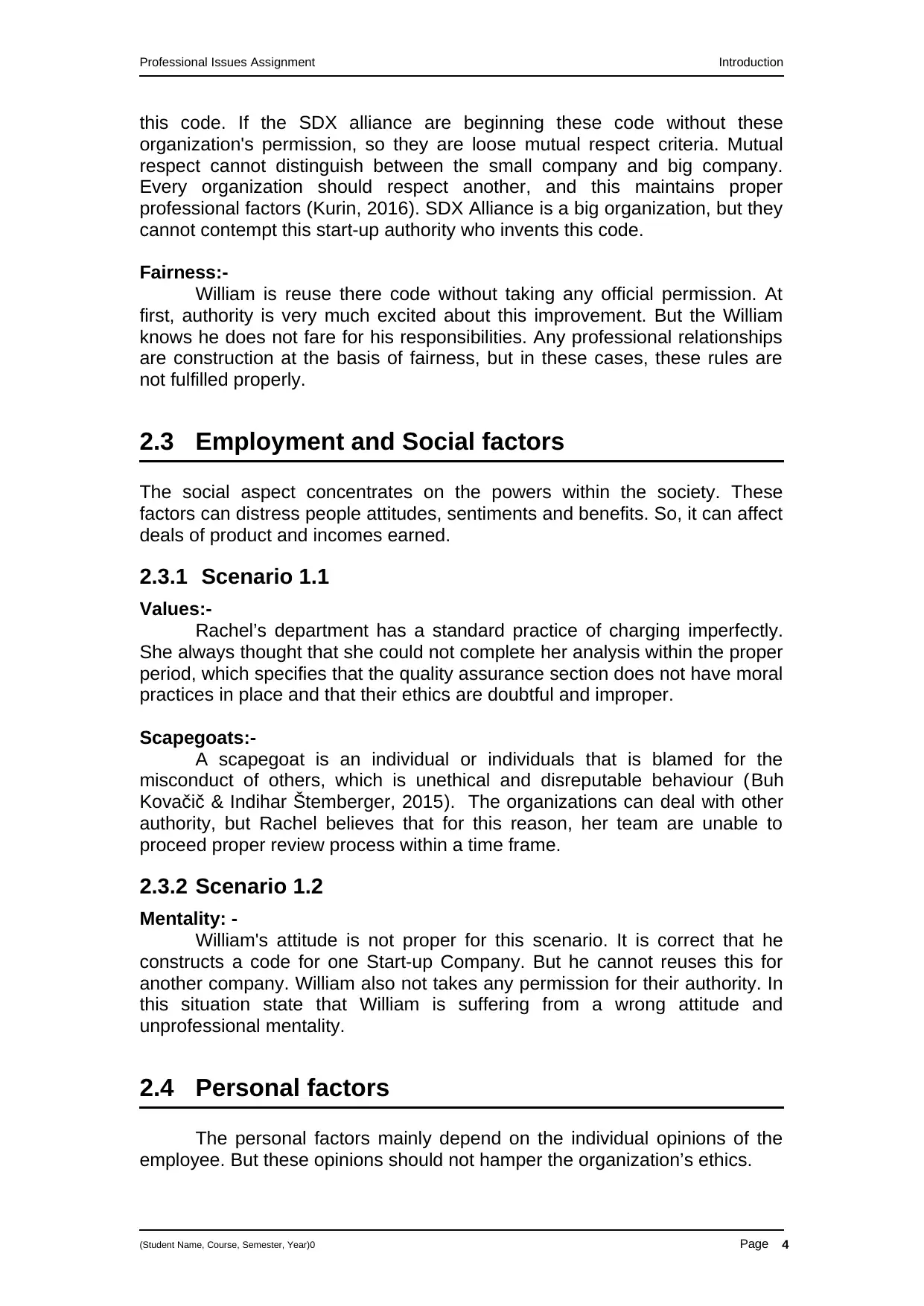
Professional Issues Assignment Introduction
this code. If the SDX alliance are beginning these code without these
organization's permission, so they are loose mutual respect criteria. Mutual
respect cannot distinguish between the small company and big company.
Every organization should respect another, and this maintains proper
professional factors (Kurin, 2016). SDX Alliance is a big organization, but they
cannot contempt this start-up authority who invents this code.
Fairness:-
William is reuse there code without taking any official permission. At
first, authority is very much excited about this improvement. But the William
knows he does not fare for his responsibilities. Any professional relationships
are construction at the basis of fairness, but in these cases, these rules are
not fulfilled properly.
2.3 Employment and Social factors
The social aspect concentrates on the powers within the society. These
factors can distress people attitudes, sentiments and benefits. So, it can affect
deals of product and incomes earned.
2.3.1 Scenario 1.1
Values:-
Rachel’s department has a standard practice of charging imperfectly.
She always thought that she could not complete her analysis within the proper
period, which specifies that the quality assurance section does not have moral
practices in place and that their ethics are doubtful and improper.
Scapegoats:-
A scapegoat is an individual or individuals that is blamed for the
misconduct of others, which is unethical and disreputable behaviour (Buh
Kovačič & Indihar Štemberger, 2015). The organizations can deal with other
authority, but Rachel believes that for this reason, her team are unable to
proceed proper review process within a time frame.
2.3.2 Scenario 1.2
Mentality: -
William's attitude is not proper for this scenario. It is correct that he
constructs a code for one Start-up Company. But he cannot reuses this for
another company. William also not takes any permission for their authority. In
this situation state that William is suffering from a wrong attitude and
unprofessional mentality.
2.4 Personal factors
The personal factors mainly depend on the individual opinions of the
employee. But these opinions should not hamper the organization’s ethics.
(Student Name, Course, Semester, Year)0 Page 4
this code. If the SDX alliance are beginning these code without these
organization's permission, so they are loose mutual respect criteria. Mutual
respect cannot distinguish between the small company and big company.
Every organization should respect another, and this maintains proper
professional factors (Kurin, 2016). SDX Alliance is a big organization, but they
cannot contempt this start-up authority who invents this code.
Fairness:-
William is reuse there code without taking any official permission. At
first, authority is very much excited about this improvement. But the William
knows he does not fare for his responsibilities. Any professional relationships
are construction at the basis of fairness, but in these cases, these rules are
not fulfilled properly.
2.3 Employment and Social factors
The social aspect concentrates on the powers within the society. These
factors can distress people attitudes, sentiments and benefits. So, it can affect
deals of product and incomes earned.
2.3.1 Scenario 1.1
Values:-
Rachel’s department has a standard practice of charging imperfectly.
She always thought that she could not complete her analysis within the proper
period, which specifies that the quality assurance section does not have moral
practices in place and that their ethics are doubtful and improper.
Scapegoats:-
A scapegoat is an individual or individuals that is blamed for the
misconduct of others, which is unethical and disreputable behaviour (Buh
Kovačič & Indihar Štemberger, 2015). The organizations can deal with other
authority, but Rachel believes that for this reason, her team are unable to
proceed proper review process within a time frame.
2.3.2 Scenario 1.2
Mentality: -
William's attitude is not proper for this scenario. It is correct that he
constructs a code for one Start-up Company. But he cannot reuses this for
another company. William also not takes any permission for their authority. In
this situation state that William is suffering from a wrong attitude and
unprofessional mentality.
2.4 Personal factors
The personal factors mainly depend on the individual opinions of the
employee. But these opinions should not hamper the organization’s ethics.
(Student Name, Course, Semester, Year)0 Page 4
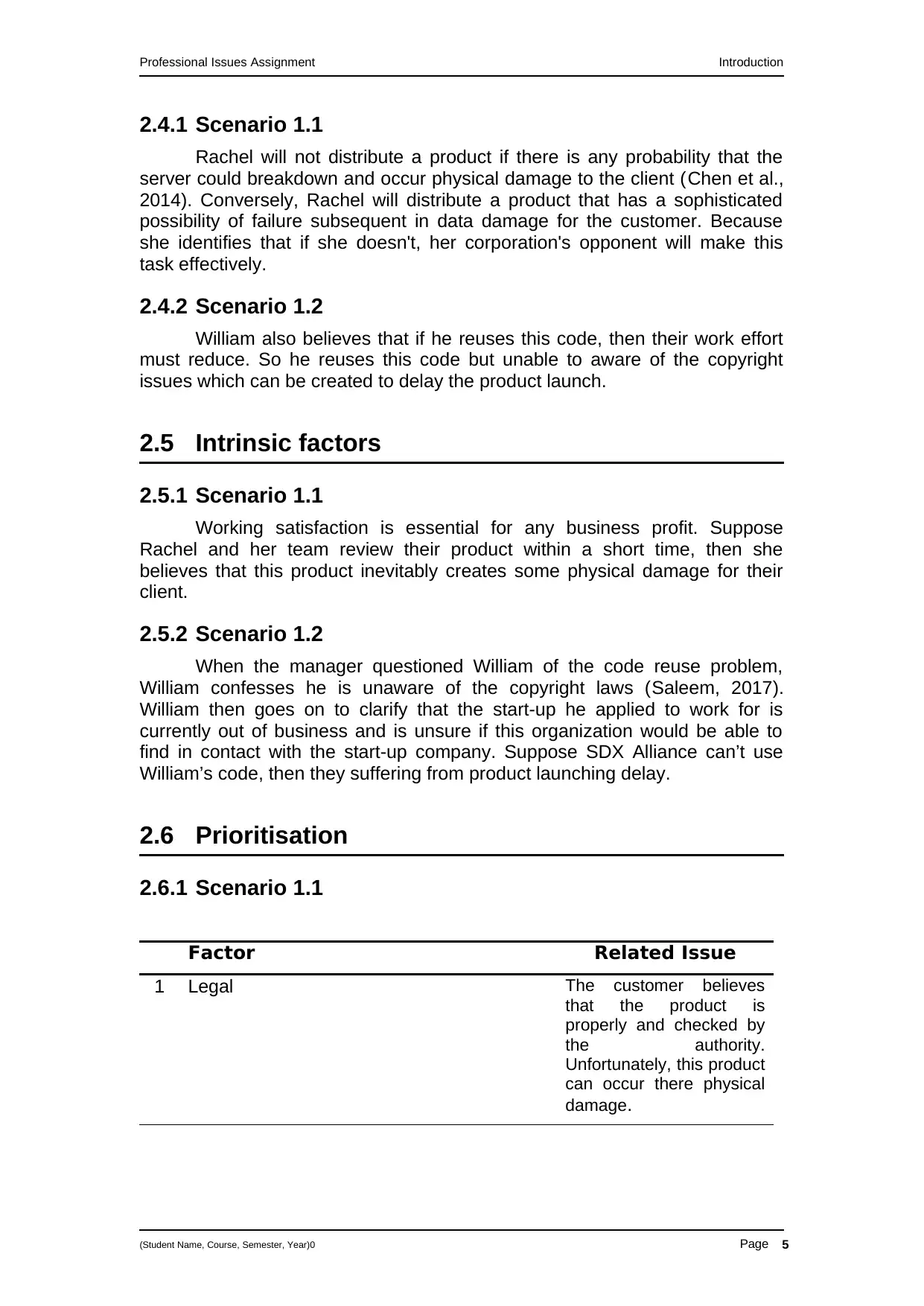
Professional Issues Assignment Introduction
2.4.1 Scenario 1.1
Rachel will not distribute a product if there is any probability that the
server could breakdown and occur physical damage to the client (Chen et al.,
2014). Conversely, Rachel will distribute a product that has a sophisticated
possibility of failure subsequent in data damage for the customer. Because
she identifies that if she doesn't, her corporation's opponent will make this
task effectively.
2.4.2 Scenario 1.2
William also believes that if he reuses this code, then their work effort
must reduce. So he reuses this code but unable to aware of the copyright
issues which can be created to delay the product launch.
2.5 Intrinsic factors
2.5.1 Scenario 1.1
Working satisfaction is essential for any business profit. Suppose
Rachel and her team review their product within a short time, then she
believes that this product inevitably creates some physical damage for their
client.
2.5.2 Scenario 1.2
When the manager questioned William of the code reuse problem,
William confesses he is unaware of the copyright laws (Saleem, 2017).
William then goes on to clarify that the start-up he applied to work for is
currently out of business and is unsure if this organization would be able to
find in contact with the start-up company. Suppose SDX Alliance can’t use
William’s code, then they suffering from product launching delay.
2.6 Prioritisation
2.6.1 Scenario 1.1
Factor Related Issue
1 Legal The customer believes
that the product is
properly and checked by
the authority.
Unfortunately, this product
can occur there physical
damage.
(Student Name, Course, Semester, Year)0 Page 5
2.4.1 Scenario 1.1
Rachel will not distribute a product if there is any probability that the
server could breakdown and occur physical damage to the client (Chen et al.,
2014). Conversely, Rachel will distribute a product that has a sophisticated
possibility of failure subsequent in data damage for the customer. Because
she identifies that if she doesn't, her corporation's opponent will make this
task effectively.
2.4.2 Scenario 1.2
William also believes that if he reuses this code, then their work effort
must reduce. So he reuses this code but unable to aware of the copyright
issues which can be created to delay the product launch.
2.5 Intrinsic factors
2.5.1 Scenario 1.1
Working satisfaction is essential for any business profit. Suppose
Rachel and her team review their product within a short time, then she
believes that this product inevitably creates some physical damage for their
client.
2.5.2 Scenario 1.2
When the manager questioned William of the code reuse problem,
William confesses he is unaware of the copyright laws (Saleem, 2017).
William then goes on to clarify that the start-up he applied to work for is
currently out of business and is unsure if this organization would be able to
find in contact with the start-up company. Suppose SDX Alliance can’t use
William’s code, then they suffering from product launching delay.
2.6 Prioritisation
2.6.1 Scenario 1.1
Factor Related Issue
1 Legal The customer believes
that the product is
properly and checked by
the authority.
Unfortunately, this product
can occur there physical
damage.
(Student Name, Course, Semester, Year)0 Page 5
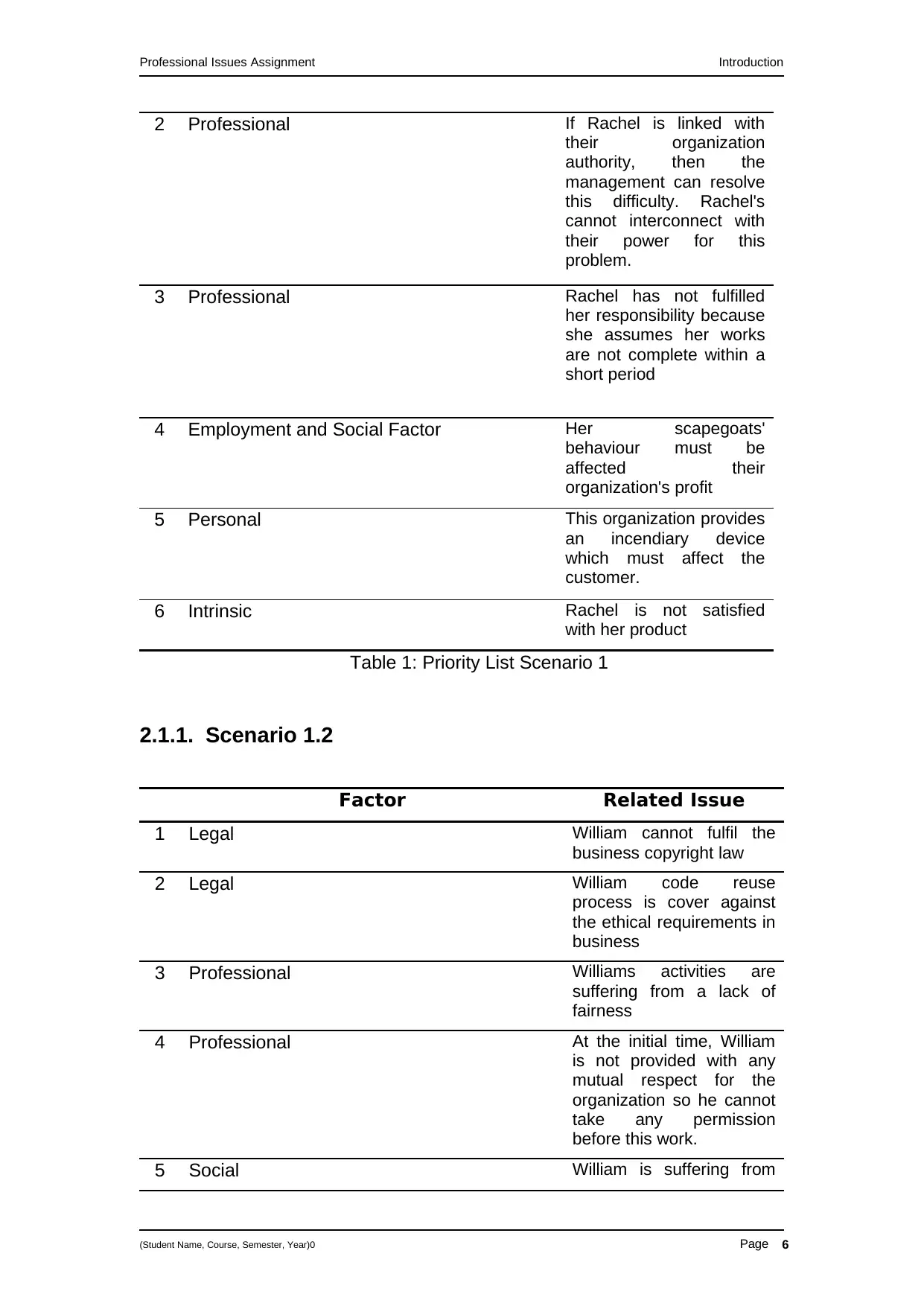
Professional Issues Assignment Introduction
2 Professional If Rachel is linked with
their organization
authority, then the
management can resolve
this difficulty. Rachel's
cannot interconnect with
their power for this
problem.
3 Professional Rachel has not fulfilled
her responsibility because
she assumes her works
are not complete within a
short period
4 Employment and Social Factor Her scapegoats'
behaviour must be
affected their
organization's profit
5 Personal This organization provides
an incendiary device
which must affect the
customer.
6 Intrinsic Rachel is not satisfied
with her product
Table 1: Priority List Scenario 1
2.1.1. Scenario 1.2
Factor Related Issue
1 Legal William cannot fulfil the
business copyright law
2 Legal William code reuse
process is cover against
the ethical requirements in
business
3 Professional Williams activities are
suffering from a lack of
fairness
4 Professional At the initial time, William
is not provided with any
mutual respect for the
organization so he cannot
take any permission
before this work.
5 Social William is suffering from
(Student Name, Course, Semester, Year)0 Page 6
2 Professional If Rachel is linked with
their organization
authority, then the
management can resolve
this difficulty. Rachel's
cannot interconnect with
their power for this
problem.
3 Professional Rachel has not fulfilled
her responsibility because
she assumes her works
are not complete within a
short period
4 Employment and Social Factor Her scapegoats'
behaviour must be
affected their
organization's profit
5 Personal This organization provides
an incendiary device
which must affect the
customer.
6 Intrinsic Rachel is not satisfied
with her product
Table 1: Priority List Scenario 1
2.1.1. Scenario 1.2
Factor Related Issue
1 Legal William cannot fulfil the
business copyright law
2 Legal William code reuse
process is cover against
the ethical requirements in
business
3 Professional Williams activities are
suffering from a lack of
fairness
4 Professional At the initial time, William
is not provided with any
mutual respect for the
organization so he cannot
take any permission
before this work.
5 Social William is suffering from
(Student Name, Course, Semester, Year)0 Page 6
Paraphrase This Document
Need a fresh take? Get an instant paraphrase of this document with our AI Paraphraser
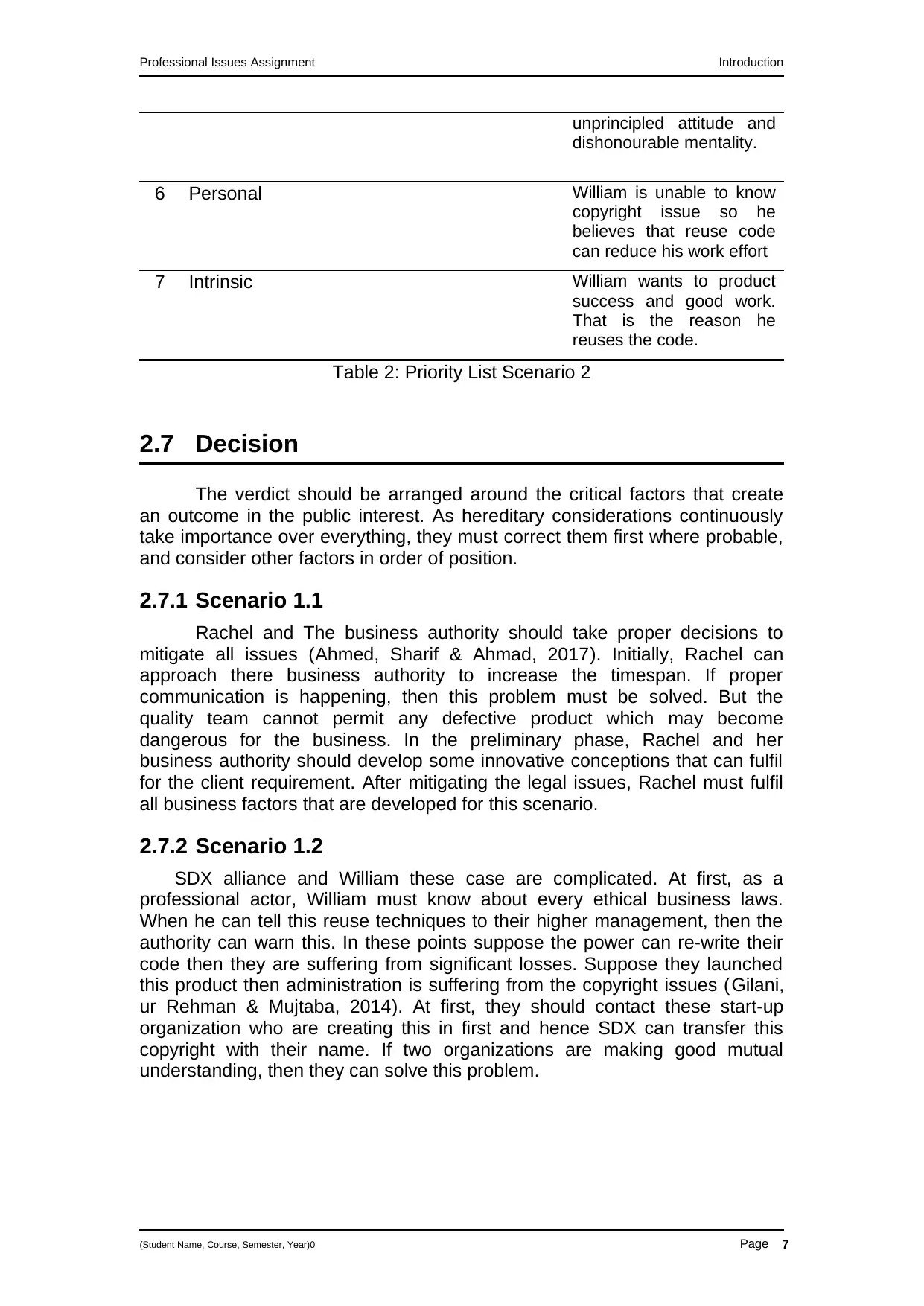
Professional Issues Assignment Introduction
unprincipled attitude and
dishonourable mentality.
6 Personal William is unable to know
copyright issue so he
believes that reuse code
can reduce his work effort
7 Intrinsic William wants to product
success and good work.
That is the reason he
reuses the code.
Table 2: Priority List Scenario 2
2.7 Decision
The verdict should be arranged around the critical factors that create
an outcome in the public interest. As hereditary considerations continuously
take importance over everything, they must correct them first where probable,
and consider other factors in order of position.
2.7.1 Scenario 1.1
Rachel and The business authority should take proper decisions to
mitigate all issues (Ahmed, Sharif & Ahmad, 2017). Initially, Rachel can
approach there business authority to increase the timespan. If proper
communication is happening, then this problem must be solved. But the
quality team cannot permit any defective product which may become
dangerous for the business. In the preliminary phase, Rachel and her
business authority should develop some innovative conceptions that can fulfil
for the client requirement. After mitigating the legal issues, Rachel must fulfil
all business factors that are developed for this scenario.
2.7.2 Scenario 1.2
SDX alliance and William these case are complicated. At first, as a
professional actor, William must know about every ethical business laws.
When he can tell this reuse techniques to their higher management, then the
authority can warn this. In these points suppose the power can re-write their
code then they are suffering from significant losses. Suppose they launched
this product then administration is suffering from the copyright issues (Gilani,
ur Rehman & Mujtaba, 2014). At first, they should contact these start-up
organization who are creating this in first and hence SDX can transfer this
copyright with their name. If two organizations are making good mutual
understanding, then they can solve this problem.
(Student Name, Course, Semester, Year)0 Page 7
unprincipled attitude and
dishonourable mentality.
6 Personal William is unable to know
copyright issue so he
believes that reuse code
can reduce his work effort
7 Intrinsic William wants to product
success and good work.
That is the reason he
reuses the code.
Table 2: Priority List Scenario 2
2.7 Decision
The verdict should be arranged around the critical factors that create
an outcome in the public interest. As hereditary considerations continuously
take importance over everything, they must correct them first where probable,
and consider other factors in order of position.
2.7.1 Scenario 1.1
Rachel and The business authority should take proper decisions to
mitigate all issues (Ahmed, Sharif & Ahmad, 2017). Initially, Rachel can
approach there business authority to increase the timespan. If proper
communication is happening, then this problem must be solved. But the
quality team cannot permit any defective product which may become
dangerous for the business. In the preliminary phase, Rachel and her
business authority should develop some innovative conceptions that can fulfil
for the client requirement. After mitigating the legal issues, Rachel must fulfil
all business factors that are developed for this scenario.
2.7.2 Scenario 1.2
SDX alliance and William these case are complicated. At first, as a
professional actor, William must know about every ethical business laws.
When he can tell this reuse techniques to their higher management, then the
authority can warn this. In these points suppose the power can re-write their
code then they are suffering from significant losses. Suppose they launched
this product then administration is suffering from the copyright issues (Gilani,
ur Rehman & Mujtaba, 2014). At first, they should contact these start-up
organization who are creating this in first and hence SDX can transfer this
copyright with their name. If two organizations are making good mutual
understanding, then they can solve this problem.
(Student Name, Course, Semester, Year)0 Page 7
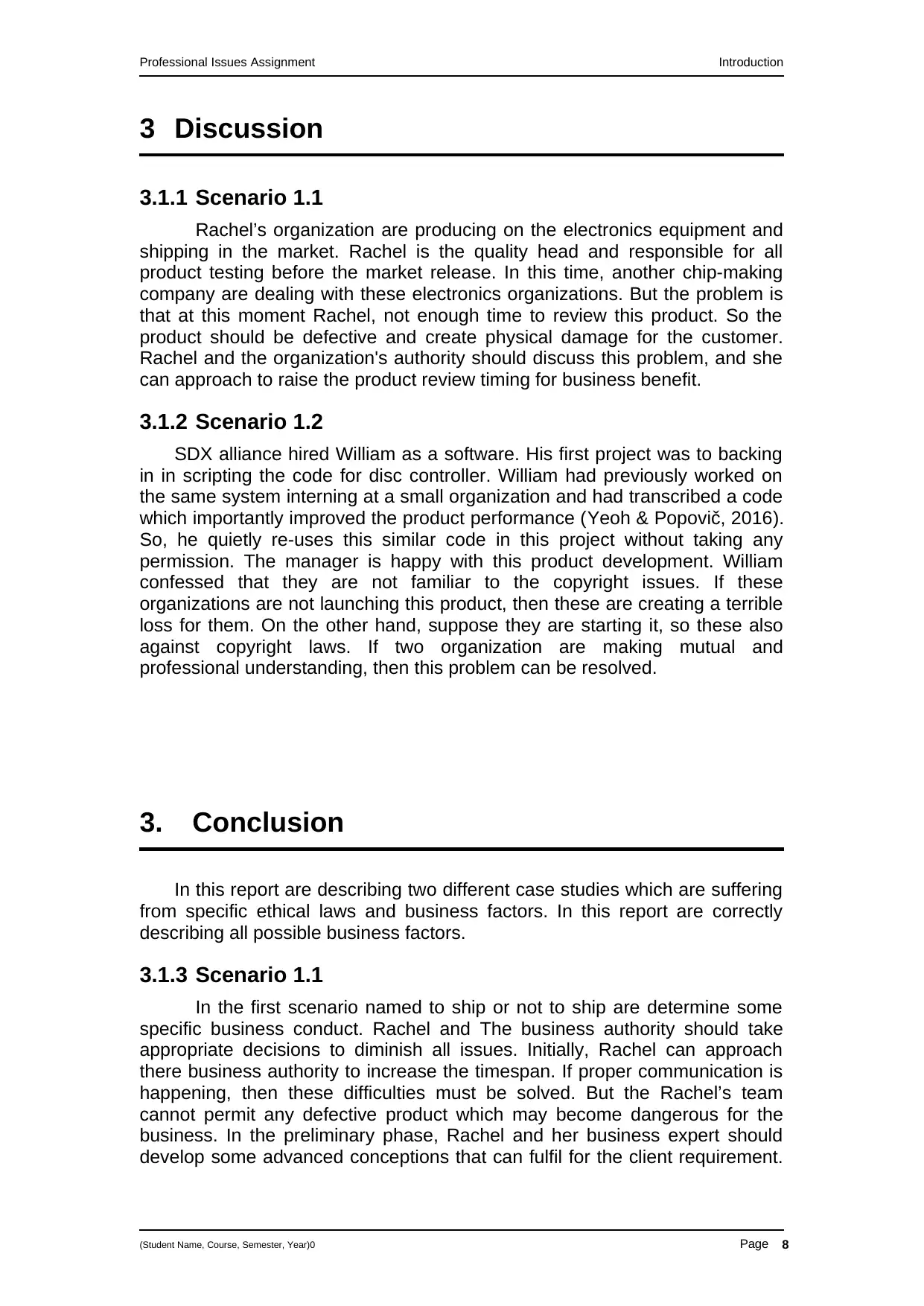
Professional Issues Assignment Introduction
3 Discussion
3.1.1 Scenario 1.1
Rachel’s organization are producing on the electronics equipment and
shipping in the market. Rachel is the quality head and responsible for all
product testing before the market release. In this time, another chip-making
company are dealing with these electronics organizations. But the problem is
that at this moment Rachel, not enough time to review this product. So the
product should be defective and create physical damage for the customer.
Rachel and the organization's authority should discuss this problem, and she
can approach to raise the product review timing for business benefit.
3.1.2 Scenario 1.2
SDX alliance hired William as a software. His first project was to backing
in in scripting the code for disc controller. William had previously worked on
the same system interning at a small organization and had transcribed a code
which importantly improved the product performance (Yeoh & Popovič, 2016).
So, he quietly re-uses this similar code in this project without taking any
permission. The manager is happy with this product development. William
confessed that they are not familiar to the copyright issues. If these
organizations are not launching this product, then these are creating a terrible
loss for them. On the other hand, suppose they are starting it, so these also
against copyright laws. If two organization are making mutual and
professional understanding, then this problem can be resolved.
3. Conclusion
In this report are describing two different case studies which are suffering
from specific ethical laws and business factors. In this report are correctly
describing all possible business factors.
3.1.3 Scenario 1.1
In the first scenario named to ship or not to ship are determine some
specific business conduct. Rachel and The business authority should take
appropriate decisions to diminish all issues. Initially, Rachel can approach
there business authority to increase the timespan. If proper communication is
happening, then these difficulties must be solved. But the Rachel’s team
cannot permit any defective product which may become dangerous for the
business. In the preliminary phase, Rachel and her business expert should
develop some advanced conceptions that can fulfil for the client requirement.
(Student Name, Course, Semester, Year)0 Page 8
3 Discussion
3.1.1 Scenario 1.1
Rachel’s organization are producing on the electronics equipment and
shipping in the market. Rachel is the quality head and responsible for all
product testing before the market release. In this time, another chip-making
company are dealing with these electronics organizations. But the problem is
that at this moment Rachel, not enough time to review this product. So the
product should be defective and create physical damage for the customer.
Rachel and the organization's authority should discuss this problem, and she
can approach to raise the product review timing for business benefit.
3.1.2 Scenario 1.2
SDX alliance hired William as a software. His first project was to backing
in in scripting the code for disc controller. William had previously worked on
the same system interning at a small organization and had transcribed a code
which importantly improved the product performance (Yeoh & Popovič, 2016).
So, he quietly re-uses this similar code in this project without taking any
permission. The manager is happy with this product development. William
confessed that they are not familiar to the copyright issues. If these
organizations are not launching this product, then these are creating a terrible
loss for them. On the other hand, suppose they are starting it, so these also
against copyright laws. If two organization are making mutual and
professional understanding, then this problem can be resolved.
3. Conclusion
In this report are describing two different case studies which are suffering
from specific ethical laws and business factors. In this report are correctly
describing all possible business factors.
3.1.3 Scenario 1.1
In the first scenario named to ship or not to ship are determine some
specific business conduct. Rachel and The business authority should take
appropriate decisions to diminish all issues. Initially, Rachel can approach
there business authority to increase the timespan. If proper communication is
happening, then these difficulties must be solved. But the Rachel’s team
cannot permit any defective product which may become dangerous for the
business. In the preliminary phase, Rachel and her business expert should
develop some advanced conceptions that can fulfil for the client requirement.
(Student Name, Course, Semester, Year)0 Page 8
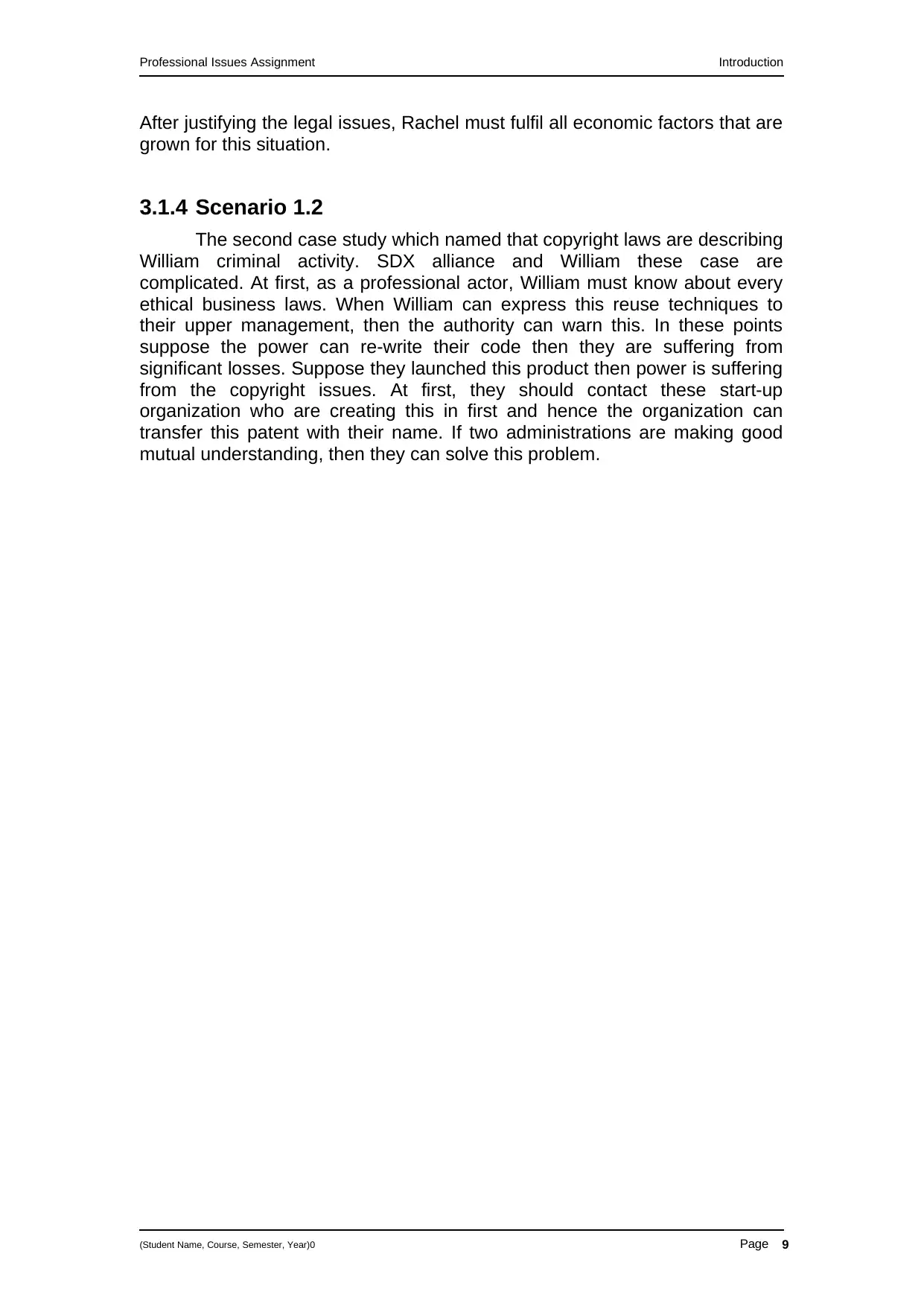
Professional Issues Assignment Introduction
After justifying the legal issues, Rachel must fulfil all economic factors that are
grown for this situation.
3.1.4 Scenario 1.2
The second case study which named that copyright laws are describing
William criminal activity. SDX alliance and William these case are
complicated. At first, as a professional actor, William must know about every
ethical business laws. When William can express this reuse techniques to
their upper management, then the authority can warn this. In these points
suppose the power can re-write their code then they are suffering from
significant losses. Suppose they launched this product then power is suffering
from the copyright issues. At first, they should contact these start-up
organization who are creating this in first and hence the organization can
transfer this patent with their name. If two administrations are making good
mutual understanding, then they can solve this problem.
(Student Name, Course, Semester, Year)0 Page 9
After justifying the legal issues, Rachel must fulfil all economic factors that are
grown for this situation.
3.1.4 Scenario 1.2
The second case study which named that copyright laws are describing
William criminal activity. SDX alliance and William these case are
complicated. At first, as a professional actor, William must know about every
ethical business laws. When William can express this reuse techniques to
their upper management, then the authority can warn this. In these points
suppose the power can re-write their code then they are suffering from
significant losses. Suppose they launched this product then power is suffering
from the copyright issues. At first, they should contact these start-up
organization who are creating this in first and hence the organization can
transfer this patent with their name. If two administrations are making good
mutual understanding, then they can solve this problem.
(Student Name, Course, Semester, Year)0 Page 9
Secure Best Marks with AI Grader
Need help grading? Try our AI Grader for instant feedback on your assignments.
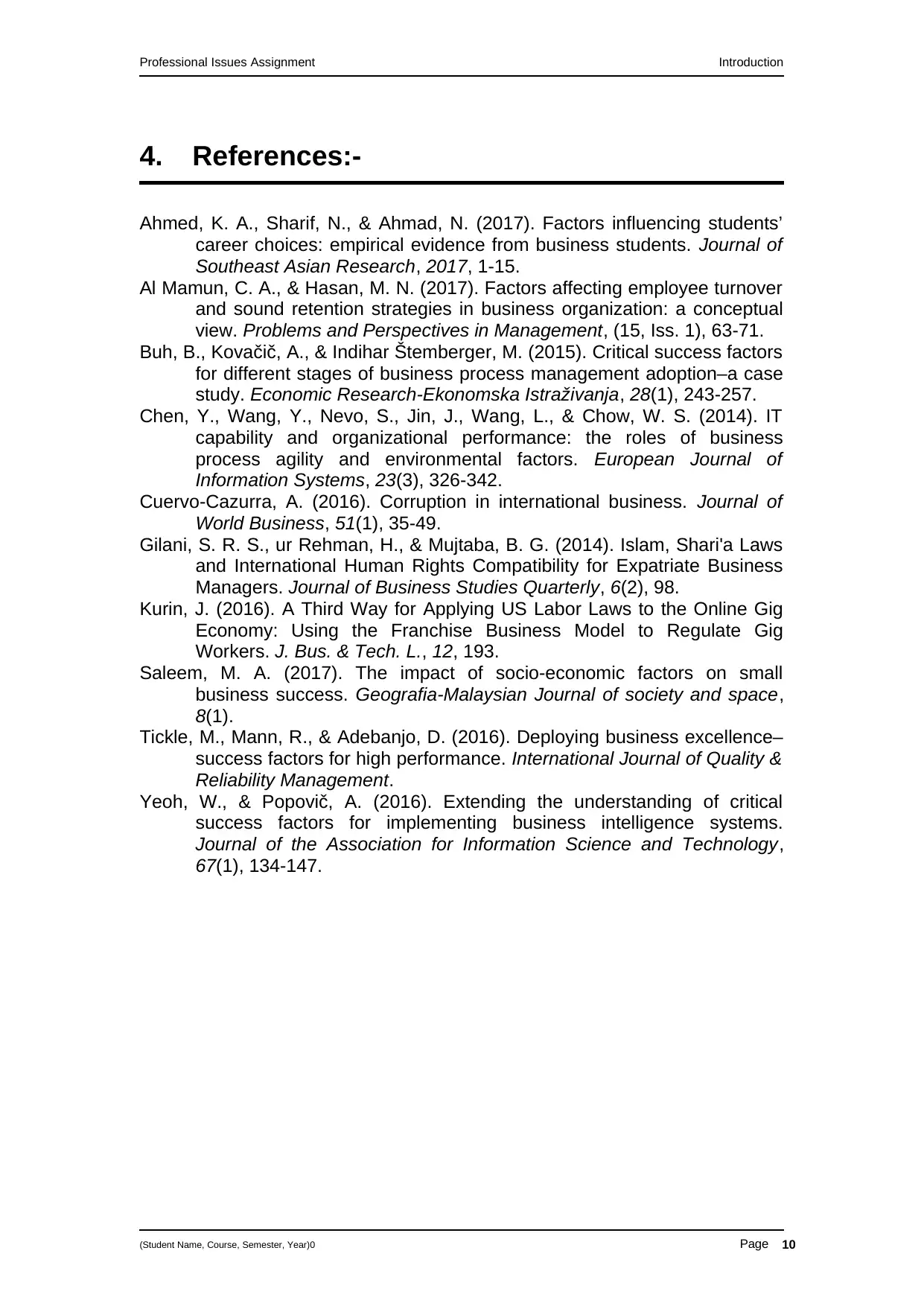
Professional Issues Assignment Introduction
4. References:-
Ahmed, K. A., Sharif, N., & Ahmad, N. (2017). Factors influencing students’
career choices: empirical evidence from business students. Journal of
Southeast Asian Research, 2017, 1-15.
Al Mamun, C. A., & Hasan, M. N. (2017). Factors affecting employee turnover
and sound retention strategies in business organization: a conceptual
view. Problems and Perspectives in Management, (15, Iss. 1), 63-71.
Buh, B., Kovačič, A., & Indihar Štemberger, M. (2015). Critical success factors
for different stages of business process management adoption–a case
study. Economic Research-Ekonomska Istraživanja, 28(1), 243-257.
Chen, Y., Wang, Y., Nevo, S., Jin, J., Wang, L., & Chow, W. S. (2014). IT
capability and organizational performance: the roles of business
process agility and environmental factors. European Journal of
Information Systems, 23(3), 326-342.
Cuervo-Cazurra, A. (2016). Corruption in international business. Journal of
World Business, 51(1), 35-49.
Gilani, S. R. S., ur Rehman, H., & Mujtaba, B. G. (2014). Islam, Shari'a Laws
and International Human Rights Compatibility for Expatriate Business
Managers. Journal of Business Studies Quarterly, 6(2), 98.
Kurin, J. (2016). A Third Way for Applying US Labor Laws to the Online Gig
Economy: Using the Franchise Business Model to Regulate Gig
Workers. J. Bus. & Tech. L., 12, 193.
Saleem, M. A. (2017). The impact of socio-economic factors on small
business success. Geografia-Malaysian Journal of society and space,
8(1).
Tickle, M., Mann, R., & Adebanjo, D. (2016). Deploying business excellence–
success factors for high performance. International Journal of Quality &
Reliability Management.
Yeoh, W., & Popovič, A. (2016). Extending the understanding of critical
success factors for implementing business intelligence systems.
Journal of the Association for Information Science and Technology,
67(1), 134-147.
(Student Name, Course, Semester, Year)0 Page 10
4. References:-
Ahmed, K. A., Sharif, N., & Ahmad, N. (2017). Factors influencing students’
career choices: empirical evidence from business students. Journal of
Southeast Asian Research, 2017, 1-15.
Al Mamun, C. A., & Hasan, M. N. (2017). Factors affecting employee turnover
and sound retention strategies in business organization: a conceptual
view. Problems and Perspectives in Management, (15, Iss. 1), 63-71.
Buh, B., Kovačič, A., & Indihar Štemberger, M. (2015). Critical success factors
for different stages of business process management adoption–a case
study. Economic Research-Ekonomska Istraživanja, 28(1), 243-257.
Chen, Y., Wang, Y., Nevo, S., Jin, J., Wang, L., & Chow, W. S. (2014). IT
capability and organizational performance: the roles of business
process agility and environmental factors. European Journal of
Information Systems, 23(3), 326-342.
Cuervo-Cazurra, A. (2016). Corruption in international business. Journal of
World Business, 51(1), 35-49.
Gilani, S. R. S., ur Rehman, H., & Mujtaba, B. G. (2014). Islam, Shari'a Laws
and International Human Rights Compatibility for Expatriate Business
Managers. Journal of Business Studies Quarterly, 6(2), 98.
Kurin, J. (2016). A Third Way for Applying US Labor Laws to the Online Gig
Economy: Using the Franchise Business Model to Regulate Gig
Workers. J. Bus. & Tech. L., 12, 193.
Saleem, M. A. (2017). The impact of socio-economic factors on small
business success. Geografia-Malaysian Journal of society and space,
8(1).
Tickle, M., Mann, R., & Adebanjo, D. (2016). Deploying business excellence–
success factors for high performance. International Journal of Quality &
Reliability Management.
Yeoh, W., & Popovič, A. (2016). Extending the understanding of critical
success factors for implementing business intelligence systems.
Journal of the Association for Information Science and Technology,
67(1), 134-147.
(Student Name, Course, Semester, Year)0 Page 10
1 out of 11
Your All-in-One AI-Powered Toolkit for Academic Success.
+13062052269
info@desklib.com
Available 24*7 on WhatsApp / Email
![[object Object]](/_next/static/media/star-bottom.7253800d.svg)
Unlock your academic potential
© 2024 | Zucol Services PVT LTD | All rights reserved.



